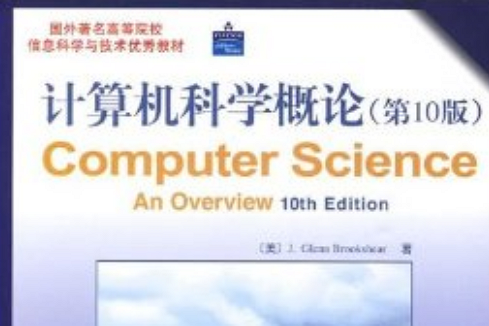《國外著名高等院校信息科學與技術優秀教材·計算機科學概論》是2009年人民郵電出版社出版的一本圖書,作者是(美國)布魯克希爾(J.Glenn Brookshear)。
基本介紹
- 書名:國外著名高等院校信息科學與技術優秀教材·計算機科學概論
- 作者:(美國)布魯克希爾(J.Glenn Brookshear)
- ISBN:9787115211163
- 頁數:666頁
- 出版社:人民郵電出版社
- 出版時間:第1版 (2009年9月1日)
- 裝幀:平裝
- 開本:16
作者簡介,內容簡介,圖書目錄,
作者簡介
作者:(美國)布魯克希爾(J.Glenn Brookshear)
J.Glenn Brooksherar,是世界知名的計算機科學教育家。他在1975年獲得新墨西哥州立大學博士學位後,創立了Marquette大學的計算機科學學位項目,並在該校任教至今。他的主要研究方向是計算理論。除了本書之外,他還著有Theory of Computation:Forma/Languages,Automata,and Complexity。
內容簡介
《計算機科學概論(第10版)(英文版)》是計算機科學導論課程的一本經典教材,全書對計算機科學做了精彩的百科全書式的全面闡述,全景式地展現了計算機科學的發展歷程、現狀及其新的技術發展趨勢。《計算機科學概論(第10版)(英文版)》首先介紹的是信息編碼及計算機體系結構的基本原理(第1章和第2章);進而是作業系統(第3章)和計算機網路(第4章)的內容,接著探討了算法、程式設計語言及軟體開發(第5章~第7章),然後探索了數據結構和資料庫(第8章和第9章)方面的問題,第10章通過圖形講述計算機技術的主要套用,第11章涉及人工智慧,第12章闡述了計算機抽象理論。
《計算機科學概論(第10版)(英文版)》在內容編排上遵循由具體到抽象推進這樣一種很利於教學的順序,每一個主題自然而然地引導出下一個主題。此外,書中還有大量的圖、表和實例,增強了讀者對知識的了解與把握。
《計算機科學概論(第10版)(英文版)》既適合作為高等院校計算機以及相關專業本科生教材,也可以供有意在計算機方面發展的非計算機專業讀者作為入門參考。
圖書目錄
Chapter 0 Introduction 1
0.1 The Role of Algorithms 2
0.2 The Origins of Computing Machines 5
0.3 The Science of Algorithms 10
0.4 Abstraction 11
0.5 An Outline of Our Study 12
0.6 Social Repercussions 14
Chapter 1 Data Storage 19
1.1 Bits and Their Storage 20
1.2 Main Memory 27
1.3 Mass Storage 30
1.4 Representing Information as Bit Patterns 38
*1.5 The Binary System 45
*1.6 Storing Integers 50
*1.7 Storing Fractions 58
*1.8 Data Compression 62
*1.9 Communication Errors 68
Chapter 2 Data Manipulation 81
2.1 Computer Architecture 82
2.2 Machine Language 85
2.3 Program Execution 92
*2.4 Arithmetic/Logic Instructions 100
*2.5 Communicating with Other Devices 105
*2.6 Other Architectures 110
Chapter 3 Operating Systems 121
3.1 The History of Operating Systems 122
3.2 Operating System Architecture 126
3.3 Coordinating the Machine's Activities 134
*3.4 Handling Competition Among Processes 138
3.5 Security 143
Chapter 4 Networking and the Internet 151
4.1 Network Fundamentals 152
4.2 The Internet 162
4.3 The World Wide Web 171
*4.4 Internet Protocols 181
4.5 Security 188
Chapter 5 Algorithms 203
5.1 The Concept of an Algorithm 204
5.2 Algorithm Representation 207
5.3 Algorithm Discovery 215
5.4 Iterative Structures 222
5.5 Recursive Structures 233
5.6 Efficiency and Correctness 242
Chapter 6 Programming Languages 261
6.1 Historical Perspective 262
6.2 Traditional Programming Concepts 271
6.3 Procedural Units 284
6.4 Language Implementation 292
6.5 Object-Oriented Programming 301
*6.6 Programming Concurrent Activities 309
*6.7 Declarative Programming 311
Chapter 7 Software Engineering 325
7.1 The Software Engineering Discipline 326
7.2 The Software Life Cycle 329
7.3 Software Engineering Methodologies 334
7.4 Modularity 336
7.5 Tools of the Trade 345
7.6 Quality Assurance 353
7.7 Documentation 357
7.8 The Human-Machine Interface 359
7.9 Software Ownership and Liability 362
Chapter 8 Data Abstractions 371
8.1 Basic Data Structure 372
8.2 Related Concepts 376
8.3 Implementing Data Structures 378
8.4 A Short Case Study 395
8.5 Customized Data Types 401
*8.6 Classes and Objects 404
*8.7 Pointers in Machine Language 406
Chapter 9 Database Systems 417
9.1 Database Fundamentals 418
9.2 The Relational Model 423
*9.3 Object-Oriented Databases 436
*9.4 Maintaining Database Integrity 439
*9.5 Traditional File Structures 443
9.6 Data Mining 452
9.7 Social Impact of Database Technology 454
Chapter 10 Computer Graphics 463
10.1 The Scope of Computer Graphics 464
10.2 Overview of 3D Graphics 466
10.3 Modeling 469
10.4 Rendering 478
*10.5 Dealing with Global Lighting 490
10.6 Animation 493
Chapter 11 Artificial Intelligence 503
11.1 Intelligence and Machines 504
11.2 Perception 509
11.3 Reasoning 515
11.4 Additional Areas of Research 528
11.5 Artificial Neural Networks 533
11.6 Robotics 542
11.7 Considering the Consequences 545
Chapter 12 Theory of Computation 555
12.1 Functions and Their Computation 556
12.2 Turing Machines 558
12.3 Universal Programming Languages 563
12.4 A Noncomputable Function 569
12.5 Complexity of Problems 575
*12.6 Public-Key Cryptography 585
Appendixes 595
A ASCII 597
B Circuits to Manipulate Two's Complement Representations 598
C A Simple Machine Language 601
D High-Level Programming Languages 604
E The Equivalence of Iterative and Recursive Structures 607
F Answers to Questions & Exercises 609
Index 655

